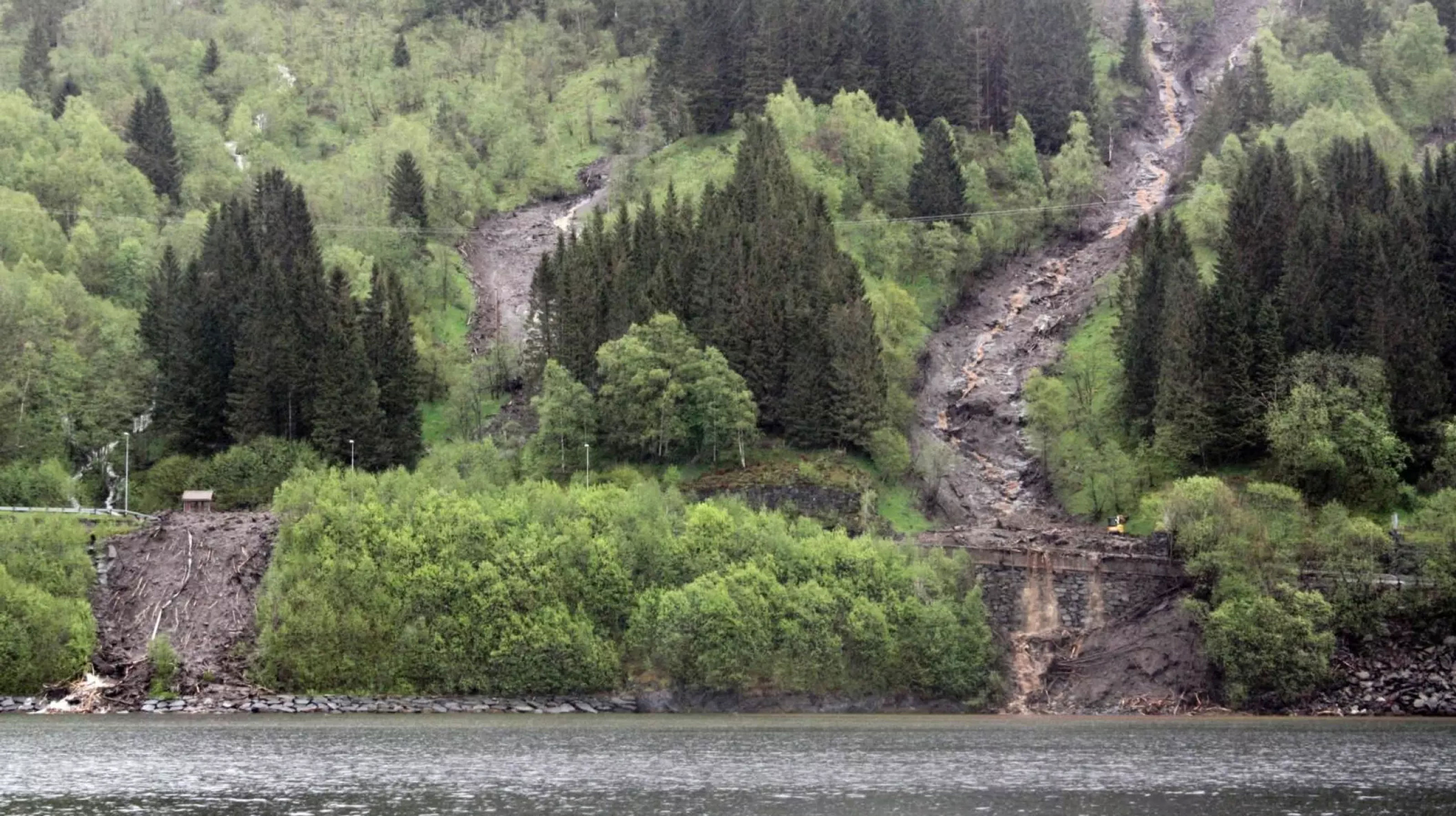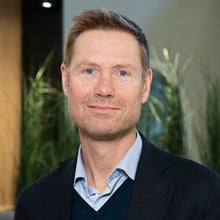More Funding Needed for Natural Hazard Research
The recent parliamentary report on floods and landslides aptly describes the seriousness of the challenges Norway faces related to natural hazards and disaster prevention. However, the report lacks binding measures, including those for research.

"If efforts to prevent weather- and nature-related incidents are not increased, the socio-economic costs will rise from about 5.5 billion kroner annually to 19 billion kroner per year by 2100," write the authors. This landslide occurred between Bergen and Voss in 2015. ( Photo: Inge Hjertaas, Bane Nor (archive).)
This op-ed was first published in Khrono and is signed by NGI's Managing Director, Lars Andresen, and NORCE's CEO, Camilla Stoltenberg.
The content of Report No. 27, A Safer Future — Prepared for Floods and Landslides, is deeply serious. We live in a country with particularly challenging soil conditions and numerous natural hazards. This combination, along with accelerating climate change, now creates major challenges in the form of more frequent floods and landslides.
Beyond the reduction of the municipal share of funding for preventive measures from 20 to 10 percent, the report largely lacks commitments and concrete follow-up measures. We therefore call for vague phrases like "the government sees the need for" and "expects" to materialize into binding and more concrete follow-up actions. Not least, the statement about "promoting research related to natural hazards and disaster prevention" must lead to increased allocations and more cross-sectoral calls for proposals.
If efforts to prevent weather- and nature-related incidents are not increased, NGI — the Norwegian Geotechnical Institute — and Menon Economics have calculated that the socio-economic costs will rise from about 5.5 billion kroner annually to 19 billion kroner per year by 2100.
There is broad agreement on the measures the government proposes to prevent and prepare for the effects of global warming: better risk assessment and prioritization of measures, more mapping, better land use planning, more precise warning services, more knowledge of nature-based solutions for stormwater, floods, and landslides, better emergency preparedness and crisis management, more coordination, and more research and knowledge dissemination.
With costly and long-term measures, including those in nature, a solid knowledge base is key to success. We at NGI and Norce look forward to contributing with continuously updated and research-based knowledge and concrete solutions.
Due to the rapid pace of climate change, there is a growing backlog in emergency and adaptation measures. Even after 12 years of mapping under state auspices aimed at existing settlements, Norway is far from fully mapped. Many municipalities are waiting for mapping, monitoring, and safeguarding by the state. NVE, together with NGI and PwC, has estimated that securing existing settlements against floods and landslides (excluding recreational buildings) will cost 85 billion kroner by 2100.
NGI and Menon Economics have examined the reasons why socio-economic measures against natural hazards are not implemented. Lack of knowledge, division of responsibility, and cooperation are three keywords. And not least, economic resources.
With the current level of funding, it will take 120 years to map all land areas that may have quick clay deposits. The government must step up efforts — in line with, among other things, the Gjerdrum Committee's recommendations (NOU 2022:3). Furthermore, we lack maps and methods for erosion risk in steep, mass-carrying rivers and a major initiative to develop digital solutions. There is also a need for better socio-economic analyses of direct and indirect costs.
The parliamentary report largely lacks visions of how holistic solutions can soon be used to provide decision-makers at various levels with more objective support in making the right decisions about prioritizing different natural hazard measures. Such solutions could include the development of digital twins that combine models for terrain, hydrology, and soil conditions. These models are suitable for digital planning and analysis with, among other things, artificial intelligence, climate projections, and various models for nature and socio-economics. NGI and Norce are working on this in various projects on a national and European scale.
To succeed in adapting to a changing climate, we must develop new, cost-effective solutions for risk management through research and development. NGI has therefore repeatedly pointed out the challenges of the lack of budgetary purposes at the Research Council that adequately cover the natural hazard area. The result is a lack of coordination and fragmented knowledge building that does not meet society's actual needs. This deficiency is confirmed by the parliamentary report. "Research within flood, landslide, and stormwater is therefore dependent on calls for proposals under thematic areas that partially overlap with natural hazard topics, or funds for basic research purposes." This is not an effective way to solve societal challenges.
Preventing and adapting to a future with more floods, landslides, and stormwater requires a holistic approach, something last year's parliamentary report on climate adaptation emphasized. The recent Report No. 27 on floods and landslides, however, inadequately addresses what the authorities will do to ensure a holistic and multidisciplinary approach. One example is so-called nature-based solutions, where nature itself is used to prevent climate-driven events. Common to these solutions is that they involve a high degree of interdisciplinarity, require space — and therefore good land use planning — and can involve many parties. This results in a comprehensive and often complex process.
Report No. 27 further confirms a concern that NGI has expressed on several occasions: Almost all projects in the last ten years have been aimed at floods and stormwater, some at rockslides and snow avalanches, while no Research Council-funded projects have been aimed at slush flows or soil slides, such as quick clay slides. The Gjerdrum Committee is clear that we will not achieve the goal of zero fatalities without prioritizing research and development.
If the words "to promote research related to natural hazards and disaster prevention" are to have value, the report must be followed up with an increase in allocations in upcoming state budgets and coordinated calls at the Research Council that promote cross-sectoral cooperation on holistic solutions in the natural hazard area.
Without a change of course, we end up with an unbinding, vague, and unclear report. This would be bad news for the government's goal of creating a safer future, prepared for floods and landslides.
